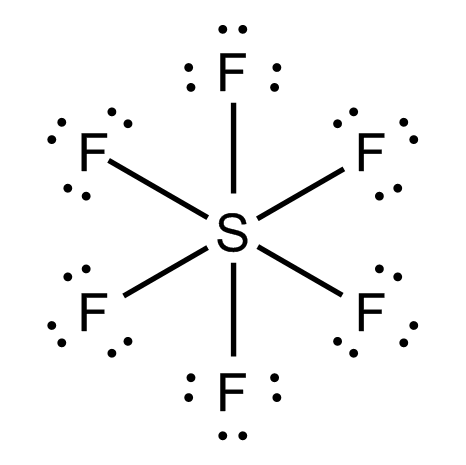
Interpretation:
The Lewis resonance structure for
Concept introduction:
Lewis structure is also known as electron − dot structure which shows the bonding between atoms of a molecule and used for atoms to show their valence electron.
Explanation of Solution
Lewis structure is a representation of the valence electrons of an atom that uses dot around the
Molecular formula formed when six fluorine atoms and one sulfur bond together
Valence electrons of S
Total
Out of 48, 12 eletrons will be involved in bonding as there are 6 S-F bonds. The reamaining 36 electrons will be presnet as lone pair of electrons on F atom. Therefore, each F atom will have 3 lone pair of electrons.
The Lewis dot structure is represneted as follows:

Sulfur Hexafluoride
For octet,
Total
Sulfur gets
For bonding electron,
each bond is made up of
then to find non - bonding (lone pair) electrons,
All the

Chapter 8 Solutions
Glencoe Chemistry: Matter and Change, Student Edition
Additional Science Textbook Solutions
Chemistry: The Central Science (13th Edition)
Introductory Chemistry (6th Edition)
Inorganic Chemistry
General Chemistry: Principles and Modern Applications (11th Edition)
Essential Organic Chemistry (3rd Edition)
Organic Chemistry (8th Edition)
 ChemistryChemistryISBN:9781305957404Author:Steven S. Zumdahl, Susan A. Zumdahl, Donald J. DeCostePublisher:Cengage Learning
ChemistryChemistryISBN:9781305957404Author:Steven S. Zumdahl, Susan A. Zumdahl, Donald J. DeCostePublisher:Cengage Learning ChemistryChemistryISBN:9781259911156Author:Raymond Chang Dr., Jason Overby ProfessorPublisher:McGraw-Hill Education
ChemistryChemistryISBN:9781259911156Author:Raymond Chang Dr., Jason Overby ProfessorPublisher:McGraw-Hill Education Principles of Instrumental AnalysisChemistryISBN:9781305577213Author:Douglas A. Skoog, F. James Holler, Stanley R. CrouchPublisher:Cengage Learning
Principles of Instrumental AnalysisChemistryISBN:9781305577213Author:Douglas A. Skoog, F. James Holler, Stanley R. CrouchPublisher:Cengage Learning Organic ChemistryChemistryISBN:9780078021558Author:Janice Gorzynski Smith Dr.Publisher:McGraw-Hill Education
Organic ChemistryChemistryISBN:9780078021558Author:Janice Gorzynski Smith Dr.Publisher:McGraw-Hill Education Chemistry: Principles and ReactionsChemistryISBN:9781305079373Author:William L. Masterton, Cecile N. HurleyPublisher:Cengage Learning
Chemistry: Principles and ReactionsChemistryISBN:9781305079373Author:William L. Masterton, Cecile N. HurleyPublisher:Cengage Learning Elementary Principles of Chemical Processes, Bind...ChemistryISBN:9781118431221Author:Richard M. Felder, Ronald W. Rousseau, Lisa G. BullardPublisher:WILEY
Elementary Principles of Chemical Processes, Bind...ChemistryISBN:9781118431221Author:Richard M. Felder, Ronald W. Rousseau, Lisa G. BullardPublisher:WILEY





